Coffee Growing with Remotely Piloted Aircraft System: Bibliometric Review
Abstract
1. Introduction
2. Methodology
2.1. Search Procedure
2.2. Organization Procedure
2.3. Bibliometric Mapping
3. Results and Discussion
3.1. Temporal Evolution of Research and Characteristics of the Studies
3.2. Performance Analysis
3.2.1. Key Publications
3.2.2. Main Journals
3.2.3. Main Researchers
3.2.4. Main Institutions
3.2.5. Main Countries
3.3. Scientific Mapping
3.3.1. Co-Citation Mapping
3.3.2. Keyword Mapping
3.3.3. Trend Mapping/Future Possibilities
4. Conclusions
Author Contributions
Funding
Data Availability Statement
Acknowledgments
Conflicts of Interest
References
- ICO. Coffee Market Report; ICO: London, UK, 2023; pp. 1–13.
- Companhia Nacional de Abastecimento—(CONAB). “Acompanhamento da Safra Brasileira—CAFÉ”. Obs. Agrícola 2023, 1, 1–60. [Google Scholar]
- Mesquita, C.; de Melo, E.M.; de Rezende, J.E.; Carvalho, J.S.; Júnior, M.A.F.; Moraes, N.C.; Dias, P.T.; Dias, P.T.; de Carvalho, R.M.; de Araújo, W.G. MANUAL DO CAFÉ: Implantação de Cafezais; EMATER-MG: Belo Horizonte, Brazil, 2016; Available online: http://www.sapc.embrapa.br/arquivos/consorcio/publicacoes_tecnicas/livro_implantacao_cafezais.pdf (accessed on 25 July 2023).
- Tang, Y.; Dananjayan, S.; Hou, C.; Guo, Q.; Luo, S.; He, Y. A survey on the 5G network and its impact on agriculture: Challenges and opportunities. Comput. Electron. Agric. 2021, 180, 105895. [Google Scholar] [CrossRef]
- Parsaeian, M.; Shahabi, M.; Hassanpour, H. Estimating Oil and Protein Content of Sesame Seeds Using Image Processing and Artificial Neural Network. J. Am. Oil Chem. Soc. 2020, 97, 691–702. [Google Scholar] [CrossRef]
- Tantalaki, N.; Souravlas, S.; Roumeliotis, M. Data-Driven Decision Making in Precision Agriculture: The Rise of Big Data in Agricultural Systems. J. Agric. Food Inf. 2019, 20, 344–380. [Google Scholar] [CrossRef]
- Liakos, K.G.; Busato, P.; Moshou, D.; Pearson, S.; Bochtis, D. Machine learning in agriculture: A review. Sensors 2018, 18, 2674. [Google Scholar] [CrossRef] [PubMed]
- Wienhold, K.; Goulao, L.F. The Embedded Agroecology of Coffee Agroforestry: A Contextualized Review of Smallholder Farmers’ Adoption and Resistance. Sustainability 2023, 15, 6827. [Google Scholar] [CrossRef]
- FAO; ITU. E-Argriculture in Action: Drones for Agriculture; ITU: Bangkok, Thailand, 2018. [Google Scholar]
- Radoglou-Grammatikis, P.; Sarigiannidis, P.; Lagkas, T.; Moscholios, I. A compilation of UAV applications for precision agriculture. Comput. Netw. 2018, 172, 107148. [Google Scholar] [CrossRef]
- Tsouros, D.C.; Bibi, S.; Sarigiannidis, P.G. A review on UAV-based applications for precision agriculture. Information 2019, 10, 349. [Google Scholar] [CrossRef]
- Limin, B.W.; Jia, L.; Lingbo, Y.; Zhongxin, C.; Xiaolong, W.; Ouyang, B. Applications of unmanned aerial vehicle images on agricultural remote sensing monitoring. Trans. Chin. Soc. Agric. Eng. 2013, 29, 136–145. [Google Scholar]
- Khan, S.; Tufail, M.; Khan, M.T.; Khan, Z.A.; Iqbal, J.; Wasim, A. Real-time recognition of spraying area for UAV sprayers using a deep learning approach. PLoS ONE 2021, 16, e0249436. [Google Scholar] [CrossRef]
- Singh, A.P.; Yerudkar, A.; Mariani, V.; Iannelli, L.; Glielmo, L. A Bibliometric Review of the Use of Unmanned Aerial Vehicles in Precision Agriculture and Precision Viticulture for Sensing Applications. Remote Sens. 2022, 14, 1604. [Google Scholar] [CrossRef]
- Pallottino, F.; Biocca, M.; Nardi, P.; Figorilli, S.; Menesatti, P.; Costa, C. Science mapping approach to analyze the research evolution on precision agriculture: World, EU and Italian situation. Precis. Agric. 2018, 19, 1011–1026. [Google Scholar] [CrossRef]
- Sott, M.K.; Furstenau, L.B.; Kipper, L.M.; Giraldo, F.D.; Lopez-Robles, J.R.; Cobo, M.J.; Zahid, A.; Abbasi, Q.H.; Imran, M.A. Precision Techniques and Agriculture 4.0 Technologies to Promote Sustainability in the Coffee Sector: State of the Art, Challenges and Future Trends. IEEE Access 2020, 8, 149854–149867. [Google Scholar] [CrossRef]
- Santana, L.S.; Ferraz, G.A.e.S.; Teodoro, A.J.d.S.; Santana, M.S.; Rossi, G.; Palchetti, E. Advances in Precision Coffee Growing Research: A Bibliometric Review. Agronomy 2021, 11, 1557. [Google Scholar] [CrossRef]
- Raparelli, E.; Bajocco, S. A bibliometric analysis on the use of unmanned aerial vehicles in agricultural and forestry studies. Int. J. Remote Sens. 2019, 40, 9070–9083. [Google Scholar] [CrossRef]
- Rejeb, A.; Rejeb, K.; Abdollahi, A.; Zailani, S.; Iranmanesh, M.; Ghobakhloo, M. Digitalization in Food Supply Chains: A Bibliometric Review and Key-Route Main Path Analysis. Sustainability 2022, 14, 83. [Google Scholar] [CrossRef]
- Mueller, S. Estudos métricos da informação em ciência e tecnologia no Brasil realizados sobre a unidade de análise artigos de periódicos? Metrical studies on science and technology information in Brazil having the scientific article as unit of analysis. Liinc em Rev. 2013, 9. [Google Scholar] [CrossRef][Green Version]
- Sales, F.O.; Marante, Y.; Vieira, A.B.; Silva, E.F. Energy Consumption Evaluation of a Routing Protocol for Low-Power and Lossy Networks in Mesh Scenarios for Precision Agriculture. Sensors 2020, 20, 3814. [Google Scholar] [CrossRef]
- Aria, M.; Cuccurullo, C. bibliometrix: An R-tool for comprehensive science mapping analysis. J. Informetr. 2017, 11, 959–975. [Google Scholar] [CrossRef]
- Moreira, P.S.d.C.; Guimarães, A.J.R.; Tsunoda, D.F. QUAL FERRAMENTA BIBLIOMÉTRICA ESCOLHER? Um estudo comparativo entre softwares. 2020, 6, 140–158. [Google Scholar] [CrossRef]
- Herwitz, S.; Johnson, L.; Dunagan, S.; Higgins, R.; Sullivan, D.; Zheng, J.; Lobitz, B.; Leung, J.; Gallmeyer, B.; Aoyagi, M.; et al. Imaging from an unmanned aerial vehicle: Agricultural surveillance and decision support. Comput. Electron. Agric. 2004, 44, 49–61. [Google Scholar] [CrossRef]
- Johnson, L.F.; Herwitz, S.R.; Lobitz, B.M.; Dunagan, S.E. Feasibility of monitoring coffee field ripeness with airborne multispectral imagery. Appl. Eng. Agric. 2004, 20, 845–849. [Google Scholar]
- Furfaro, R.; Ganapol, B.D.; Johnson, L.F.; Herwitz, S.R. Neural Network Algorithm for Coffee Ripeness Evaluation Using Airborne Images. Appl. Eng. Agric. 2007, 23, 379–387. [Google Scholar] [CrossRef]
- Garcia-Cedeno, A.; Guillermo, J.C.; Barzallo, B.; Punin, C.; Soto, A.; Rivas, D.; Clotet, R.; Huerta, M. PLATANO: Intelligent Technological Support Platform for Azuay province Farmers in Ecuador. In Proceedings of the 2019 IEEE International Conference on Engineering Veracruz (ICEV), Boca del Rio, Mexico, 14–17 October 2019; pp. 1–7. [Google Scholar]
- Oliveira, H.C.; Guizilini, V.C.; Nunes, I.P.; Souza, J.R. Failure Detection in Row Crops from UAV Images Using Morphological Operators. IEEE Geosci. Remote Sens. Lett. 2018, 15, 991–995. [Google Scholar] [CrossRef]
- Soares, G.A.; Abdala, D.; Escarpinati, M. Plantation Rows Identification by Means of Image Tiling and Hough Transform Grouping. In Proceedings of the 13th International Joint Conference on Computer Vision, Imaging and Computer Graphics Theory and Applications—VISIGRAPP 2018, Madeira, Portugal, 27–29 January 2018; pp. 453–459. [Google Scholar]
- Da Cunha, J.P.A.R.; Neto, M.A.S.; Hurtado, S.M.C. Estimating vegetation volume of coffee crops using images from unmanned aerial vehicles. Eng. Agríc. 2019, 39, 41–47. [Google Scholar] [CrossRef]
- Dos Santos, L.M.; e Silva Ferraz, G.A.; Andrade, M.T.; Santana, L.S.; de Barbosa, B.D.S.; Maciel, D.A.; Rossi, G. Analysis of flight parameters and georeferencing of images with different control points obtained by RPA. Agron. Res. 2019, 17, 2054–2063. [Google Scholar] [CrossRef]
- dos Santos, L.M.; Ferraz, G.A.e.S.; Barbosa, B.D.d.S.; Diotto, A.V.; Maciel, D.T.; Xavier, L.A.G. Biophysical parameters of coffee crop estimated by UAV RGB images. Precis. Agric. 2020, 21, 1227–1241. [Google Scholar] [CrossRef]
- Oré, G.; Alcântara, M.S.; Góes, J.A.; Oliveira, L.P.; Yepes, J.; Teruel, B.; Castro, V.; Bins, L.S.; Castro, F.; Luebeck, D.; et al. Crop Growth Monitoring with Drone-Borne DInSAR. Remote Sens. 2020, 12, 615. [Google Scholar] [CrossRef]
- Wei, P.; Jiang, T.; Peng, H.; Jin, H.; Sun, H.; Chai, D.; Huang, J. Coffee Flower Identification Using Binarization Algorithm Based on Convolutional Neural Network for Digital Images. Plant Phenom. 2020, 2020, 6323965. [Google Scholar] [CrossRef]
- Parreiras, T.C.; Lense, G.H.E.; Moreira, R.S.; Santana, D.B.; Mincato, R.L. Using unmanned aerial vehicle and machine learning algorithm to monitor leaf nitrogen in coffee. Coffee Sci. 2020, 15, 1–9. [Google Scholar] [CrossRef]
- Santos, L.M.; Parreiras, T.C.; Lense, G.H.E.; Santana, D.B.; Moreira, R.S. Coffee crop coefficient prediction as a function of biophysical variables identified from RGB UAS images. Agron. Res. 2020, 18, 1463–1471. [Google Scholar] [CrossRef]
- dos Santos, L.M.; Ferraz, G.A.e.S.; Barbosa, B.D.d.S.; Diotto, A.V.; Andrade, M.T.; Conti, L.; Rossi, G. Determining the Leaf Area Index and Percentage of Area Covered by Coffee Crops Using UAV RGB Images. IEEE J. Sel. Top. Appl. Earth Obs. Remote Sens. 2020, 13, 6401–6409. [Google Scholar] [CrossRef]
- Velásquez, D.; Sánchez, A.; Sarmiento, S.; Toro, M.; Maiza, M.; Sierra, B. A Method for Detecting Coffee Leaf Rust through Wireless Sensor Networks, Remote Sensing, and Deep Learning: Case Study of the Caturra Variety in Colombia. Appl. Sci. 2020, 10, 697. [Google Scholar] [CrossRef]
- Barbosa, B.D.S.; Ferraz, G.A.E.S.; Santos, L.M.; Santana, L.S.; Marin, D.B.; Rossi, G.; Conti, L. Application of RGB Images Obtained by UAV in Coffee Farming. Remote Sens. 2021, 13, 2397. [Google Scholar] [CrossRef]
- Marin, D.B.; Ferraz, G.A.e.S.; Santana, L.S.; Barbosa, B.D.S.; Barata, R.A.P.; Osco, L.P.; Ramos, A.P.M.; Guimarães, P.H.S. Detecting coffee leaf rust with UAV-based vegetation indices and decision tree machine learning models. Comput. Electron. Agric. 2021, 190, 106476. [Google Scholar] [CrossRef]
- Barbosa, B.D.S.; Ferraz, G.A.e.S.; Costa, L.; Ampatzidis, Y.; Vijayakumar, V.; dos Santos, L.M. UAV-based coffee yield prediction utilizing feature selection and deep learning. Smart Agric. Technol. 2021, 1, 100010. [Google Scholar] [CrossRef]
- Santana, L.S.; e Silva Ferraz, G.A.; Cunha, J.P.B.; Santana, M.S.; de Faria, R.O.; Marin, D.B.; Rossi, G.; Conti, L.; Vieri, M.; Sarri, D. Monitoring Errors of Semi-Mechanized Coffee Planting by Remotely Piloted Aircraft. Agronomy 2021, 11, 1224. [Google Scholar] [CrossRef]
- Marin, D.B.; Ferraz, G.A.e.S.; Guimarães, P.H.S.; Schwerz, F.; Santana, L.S.; Barbosa, B.D.S.; Barata, R.A.P.; Faria, R.d.O.; Dias, J.E.L.; Conti, L.; et al. Remotely Piloted Aircraft and Random Forest in the Evaluation of the Spatial Variability of Foliar Nitrogen in Coffee Crop. Remote Sens. 2021, 13, 1471. [Google Scholar] [CrossRef]
- Rivera, L.B.; Bonilla, B.M.; Obando-Vidal, F. Procesamiento de imágenes multiespectrales captadas con drones para evaluar el índice de vegetación de diferencia normalizada en plantaciones de café variedad Castillo. Cienc. Y Tecnol. Agropecu. 2021, 22, 1578. [Google Scholar] [CrossRef]
- dos Santos, S.A.; Ferraz, G.A.e.S.; Figueiredo, V.C.; Santana, L.S.; Campos, B.F.D. Supervised classification and NDVI calculation from remote piloted aircraft images for coffee plantations applications. Coffee Sci. 2021, 16, 1–9. [Google Scholar] [CrossRef]
- Martins, R.N.; Pinto, F.d.A.d.C.; de Queiroz, D.M.; Valente, D.S.M.; Rosas, J.T.F. A Novel Vegetation Index for Coffee Ripeness Monitoring Using Aerial Imagery. Remote Sens. 2021, 13, 263. [Google Scholar] [CrossRef]
- Felix, F.C.; Avalos, F.A.; DE Lima, W.; Cândido, B.M.; Silva, M.L.; Mincato, R.L. Seasonal behavior of vegetation determined by sensor on an unmanned aerial vehicle. An. Da Acad. Bras. De Ciências 2021, 93, e20200712. [Google Scholar] [CrossRef] [PubMed]
- Gomes, A.P.A.; de Queiroz, D.M.; Valente, D.S.M.; Pinto, F.d.A.d.C.; Rosas, J.T.F. Comparing a Single-Sensor Camera with a Multisensor Camera for Monitoring Coffee Crop using Unmanned Aerial Vehicles. Eng. Agrícola 2021, 41, 87–97. [Google Scholar] [CrossRef]
- Rosas, J.T.F.; Pinto, F.d.A.d.C.; de Queiroz, D.M.; Villar, F.M.d.M.; Martins, R.N.; Silva, S.d.A. Low-cost system for radiometric calibration of UAV-based multispectral imagery. J. Spat. Sci. 2020, 67, 395–409. [Google Scholar] [CrossRef]
- Santana, L.S.; Ferraz, G.A.e.S.; Marin, D.B.; Faria, R.d.O.; Santana, M.S.; Rossi, G.; Palchetti, E. Digital Terrain Modelling by Remotely Piloted Aircraft: Optimization and Geometric Uncertainties in Precision Coffee Growing Projects. Remote Sens. 2022, 14, 911. [Google Scholar] [CrossRef]
- Bento, N.L.; Ferraz, G.A.E.S.; Barata, R.A.P.; Santana, L.S.; Barbosa, B.D.S.; Conti, L.; Becciolini, V.; Rossi, G. Overlap influence in images obtained by an unmanned aerial vehicle on a digital terrain model of altimetric precision. Eur. J. Remote Sens. 2022, 55, 263–276. [Google Scholar] [CrossRef]
- Souza, F.G.; Souza, F.G.; Portes, M.F.; Portes, M.F.; Silva, M.V.; Silva, M.V.; Teixeira, M.M.; Teixeira, M.M.; Júnior, M.R.F.; Júnior, M.R.F. Impact of sprayer drone flight height on droplet spectrum in mountainous coffee plantation. Rev. Bras. De Eng. Agrícola E Ambient. 2022, 26, 901–906. [Google Scholar] [CrossRef]
- da Vitória, E.L.; de Oliveira, R.F.; Crause, D.H.; Ribeiro, L.F.O. Effect of flight operative height and genotypes on conilon coffee spraying using an unmanned aerial vehicle. Coffee Sci. 2022, 17, 1–9. [Google Scholar] [CrossRef]
- Bento, N.L.; Ferraz, G.A.e.S.; Barata, R.A.P.; Soares, D.V.; dos Santos, L.M.; Santana, L.S.; Ferraz, P.F.P.; Conti, L.; Palchetti, E. Characterization of Recently Planted Coffee Cultivars from Vegetation Indices Obtained by a Remotely Piloted Aircraft System. Sustainability 2022, 14, 1446. [Google Scholar] [CrossRef]
- Rosas, J.T.F.; Pinto, F.d.A.d.C.; de Queiroz, D.M.; Villar, F.M.d.M.; Valente, D.S.M.; Martins, R.N. Coffee ripeness monitoring using a UAV-mounted low-cost multispectral camera. Precis. Agric. 2022, 23, 300–318. [Google Scholar] [CrossRef]
- Bento, N.L.; Ferraz, G.A.S.; Barata, R.A.P.; Santana, L.S.; Faria, R.O.; Soares, D.V. Evaluation of coffee plant attributes by field collection and remotely piloted aircraft system images. Span. J. Agric. Res. 2022, 20, e0205. [Google Scholar] [CrossRef]
- Martello, M.; Molin, J.P.; Angnes, G.; Acorsi, M.G. Assessing the Temporal and Spatial Variability of Coffee Plantation Using RPA-Based RGB Imaging. Drones 2022, 6, 267. [Google Scholar] [CrossRef]
- Bento, N.L.; Ferraz, G.A.e.S.; Barata, R.A.P.; Soares, D.V.; Santana, L.S.; Barbosa, B.D.S. Estimate and Temporal Monitoring of Height and Diameter of the Canopy of Recently Transplanted Coffee by a Remotely Piloted Aircraft System. Agriengineering 2022, 4, 207–215. [Google Scholar] [CrossRef]
- dos Santos, L.M.; Ferraz, G.A.e.S.; Carvalho, M.A.d.F.; Teodoro, S.A.; Campos, A.A.V.; Neto, P.M. Use of RPA Images in the Mapping of the Chlorophyll Index of Coffee Plants. Sustainability 2022, 14, 13118. [Google Scholar] [CrossRef]
- Arteaga-López, N.; Delgado-Calvache, C.; Casanova, J.-F.; Figeroa, C. Coffee Crops Analysis Using UAVs Equipped with Multispectral Cameras. Rev. Fac. Ing. 2022, 31, e14870. [Google Scholar] [CrossRef]
- dos Santos, L.M.; Ferraz, G.A.e.S.; Marin, D.B.; Carvalho, M.A.d.F.; Dias, J.E.L.; Alecrim, A.d.O.; Silva, M.d.L.O.e. Vegetation Indices Applied to Suborbital Multispectral Images of Healthy Coffee and Coffee Infested with Coffee Leaf Miner. Agriengineering 2022, 4, 311–319. [Google Scholar] [CrossRef]
- Pereira, F.V.; Martins, G.D.; Vieira, B.S.; de Assis, G.A.; Orlando, V.S.W. Multispectral images for monitoring the physiological parameters of coffee plants under different treatments against nematodes. Precis. Agric. 2022, 23, 2312–2344. [Google Scholar] [CrossRef]
- Soares, A.d.S.; Vieira, B.S.; Bezerra, T.A.; Martins, G.D.; Siquieroli, A.C.S. Early Detection of Coffee Leaf Rust Caused by Hemileia vastatrix Using Multispectral Images. Agronomy 2022, 12, 2911. [Google Scholar] [CrossRef]
- Inoue, Y. Satellite- and drone-based remote sensing of crops and soils for smart farming—A review. Soil Sci. Plant Nutr. 2020, 66, 798–810. [Google Scholar] [CrossRef]
- Osco, L.P.; Marcato Junior, J.; Marques Ramos, A.P.; de Castro Jorge, L.A.; Fatholahi, S.N.; de Andrade Silva, J.; Matsubara, E.T.; Pistori, H.; Gonçalves, W.N.; Li, J. A Review on Deep Learning in UAV Remote Sensing. Int. J. Appl. Earth Obs. Geoinf. 2021, 102, 102456. [Google Scholar] [CrossRef]
- Koutsos, T.M.; Menexes, G.C.; Dordas, C.A. An efficient framework for conducting systematic literature reviews in agricultural sciences. Sci. Total. Environ. 2019, 682, 106–117. [Google Scholar] [CrossRef] [PubMed]
- Ren, J.; Jing, X.; Wang, J.; Ren, X.; Xu, Y.; Yang, Q.; Ma, L.; Sun, Y.; Xu, W.; Yang, N.; et al. Automatic Recognition of Laryngoscopic Images Using a Deep-Learning Technique. Laryngoscope 2020, 130, E686–E693. [Google Scholar] [CrossRef] [PubMed]
- Yost, M.A.; Kitchen, N.R.; Sudduth, K.A.; Massey, R.E.; Sadler, E.J.; Drummond, S.T.; Volkmann, M.R. A long-term precision agriculture system sustains grain profitability. Precis. Agric. 2019, 20, 1177–1198. [Google Scholar] [CrossRef]
- Gusenbauer, M. The age of abundant scholarly information and its synthesis– A time when ‘just google it’ is no longer enough. Res. Synth. Methods 2021, 12, 684–691. [Google Scholar] [CrossRef] [PubMed]
- Gusenbauer, M. Search where you will find Amost: Comparing the disciplinary coverage of 56 bibliographic databases. Scientometrics 2022, 127, 2683–2745. [Google Scholar] [CrossRef]
- Merigó, J.M.; Yang, J.-B. A bibliometric analysis of operations research and management science. Omega 2017, 73, 37–48. [Google Scholar] [CrossRef]
- Ferreira, M.P.; Pinto, C.F.; Serra, F.R. The transaction costs theory in international business research: A bibliometric study over three decades. Scientometrics 2013, 98, 1899–1922. [Google Scholar] [CrossRef]
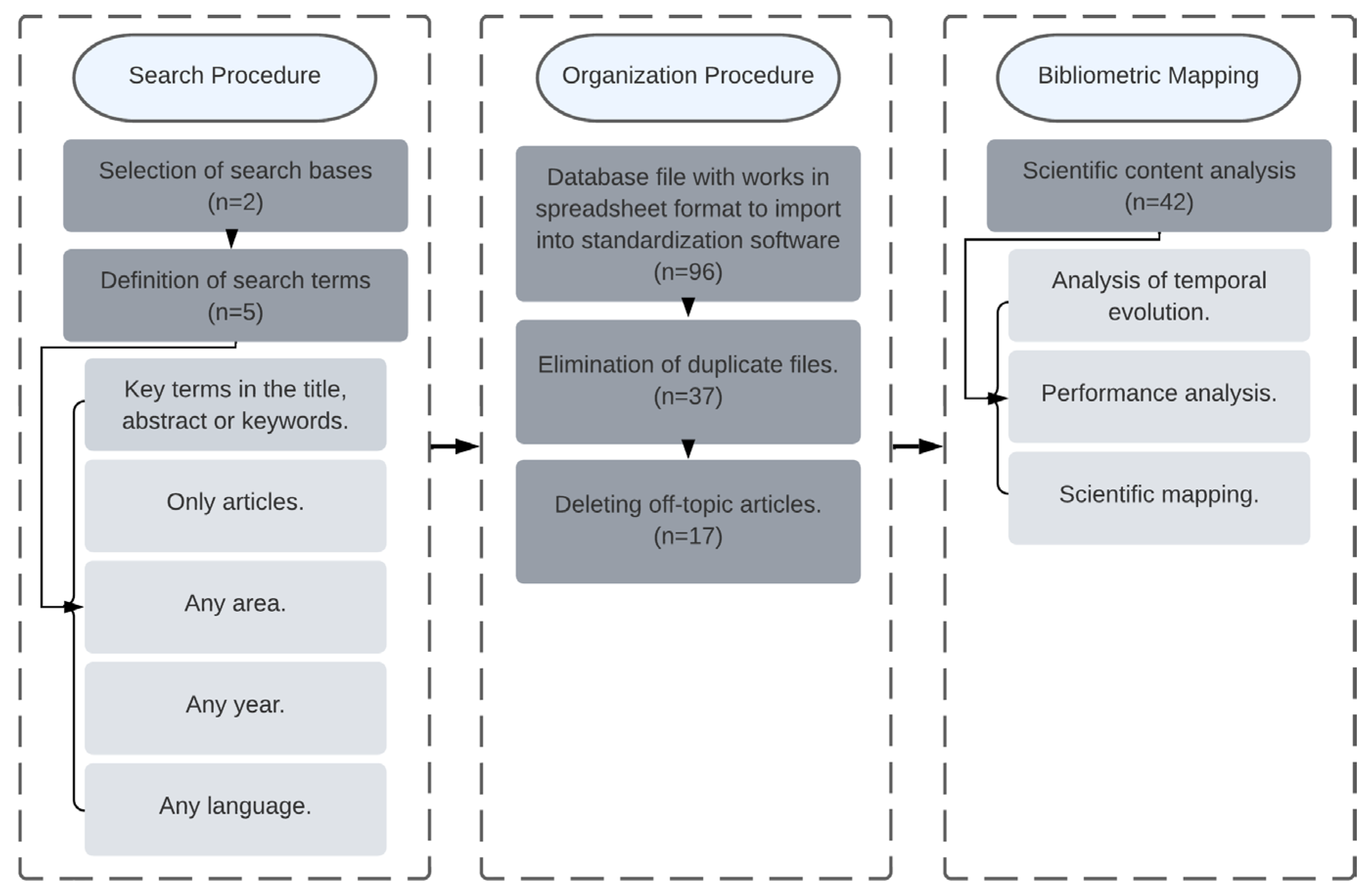

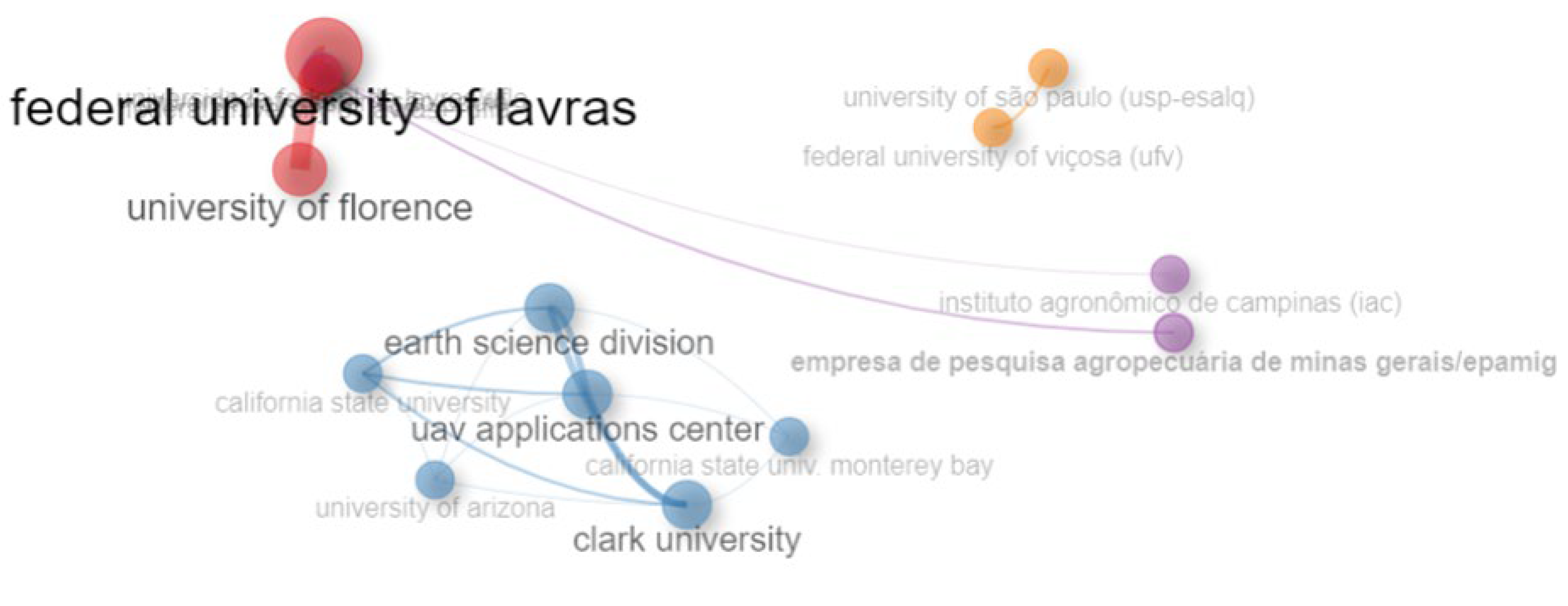

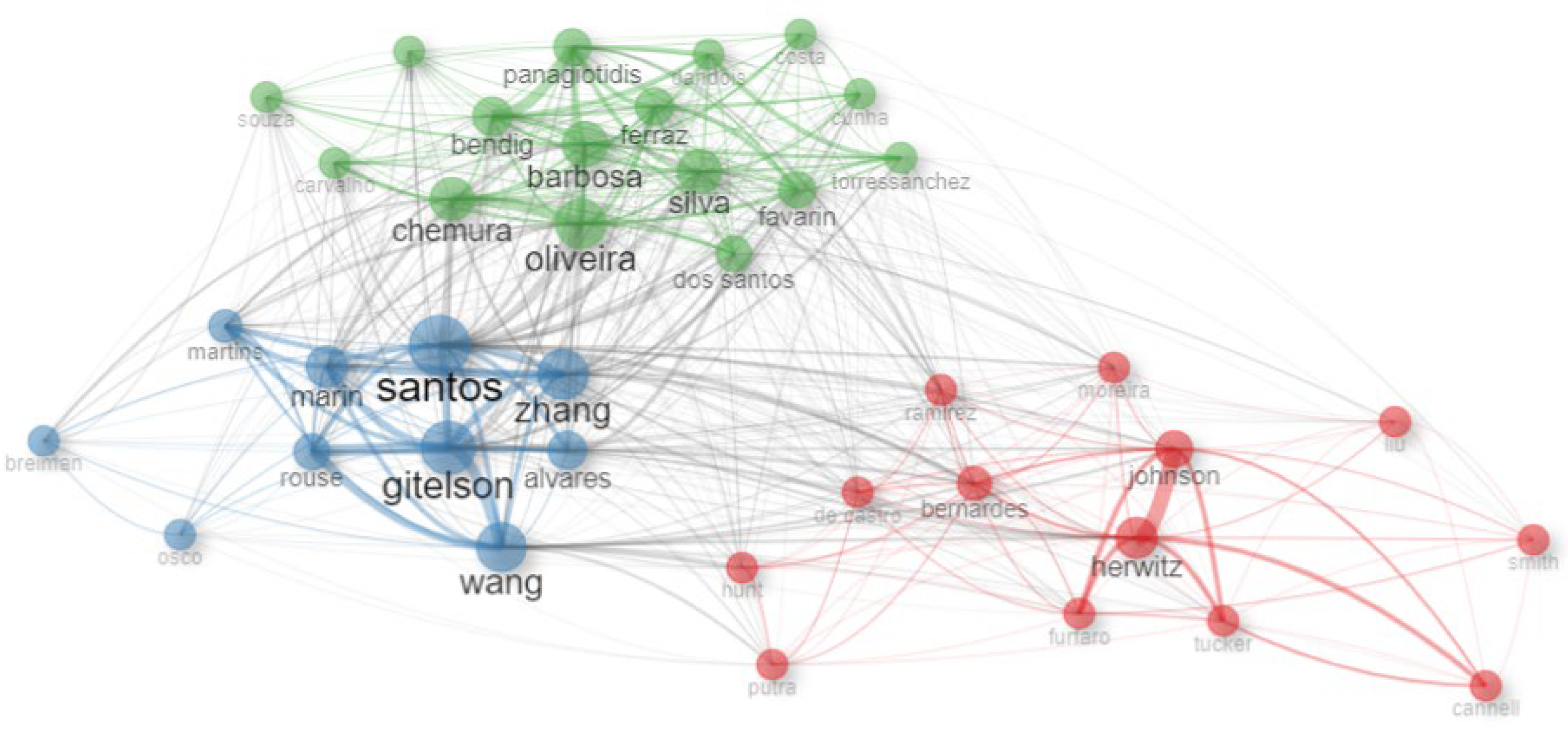
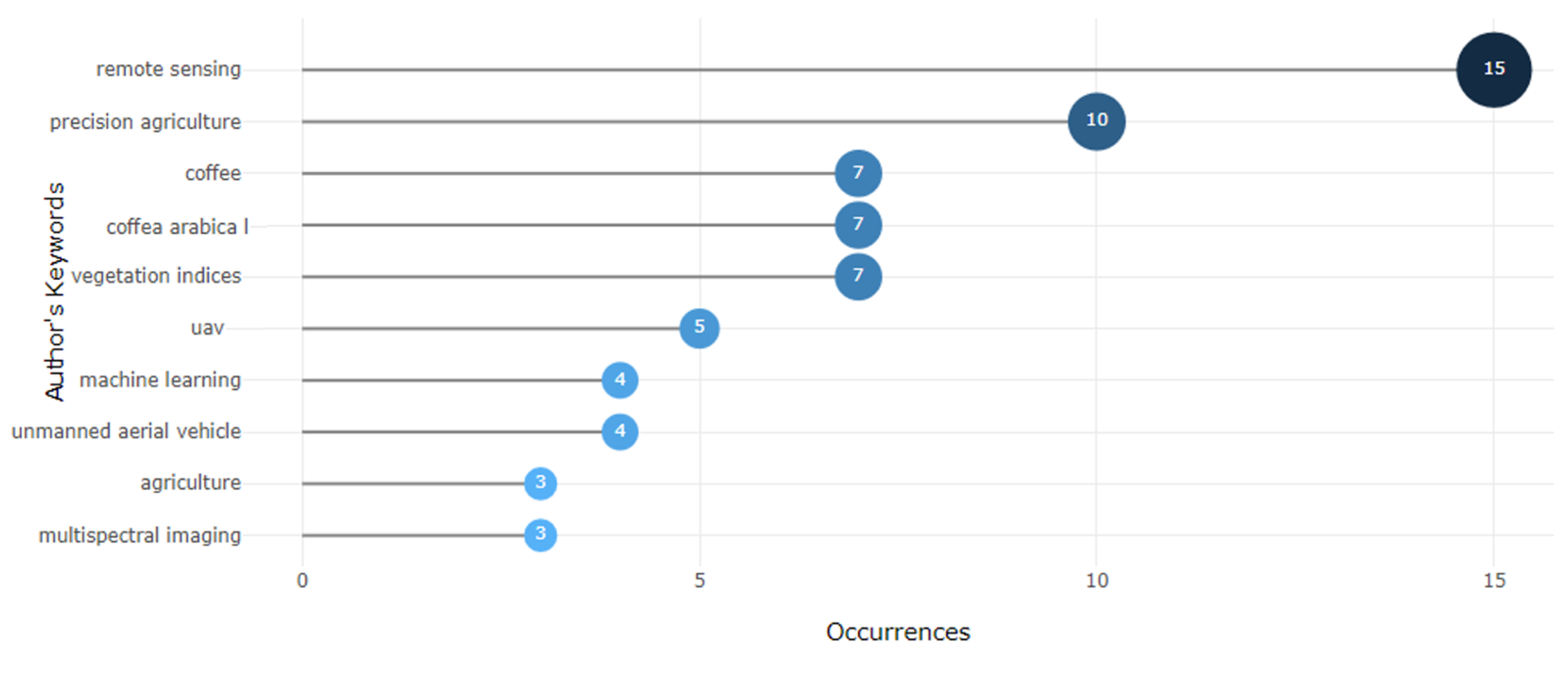
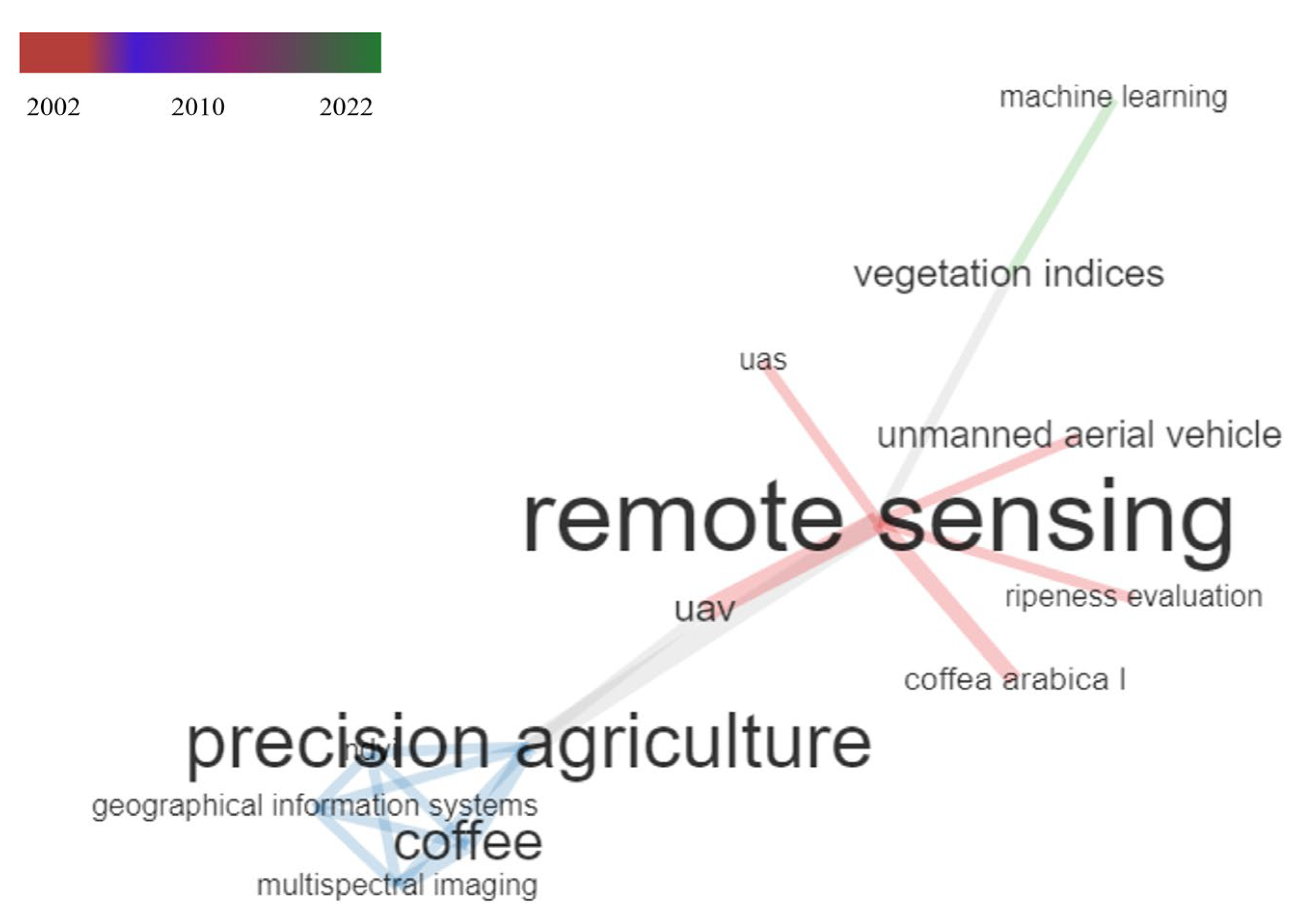
| Central Themes | Papers |
|---|---|
| Agricultural Monitoring | [24,28,29,30,42,50,51,52,53,57] |
| Vegetation Indices | [35,41,43,44,45,46,48,54,55,59,60] |
| Biophysical Characteristics | [32,33,36,37,39,58] |
| Pests and Diseases | [38,40,61,62,63] |
| Agricultural Yield | [25,26,34,56] |
| Perspectives on Technology | [17,31,47,49] |
| R | Title | Authors | PY | Journal | NC |
|---|---|---|---|---|---|
| 1° | Imaging From An Unmanned Aerial Vehicle Agricultural Surveillance And Decision Support | HERWITZ et al. [24] | 2004 | Computers and Electronics in Agriculture | 316 |
| 2° | Feasibility Of Monitoring Coffee Field Ripeness With Airborne Multispectral Imagery | JOHNSON et al. [25] | 2004 | Applied Engineering in Agriculture | 39 |
| 3° | A Method For Detecting Coffee Leaf Rust Through Wireless Sensor Networks Remote Sensing And Deep Learning Case Study Of The Caturra Variety In Colombia | VELÁSQUEZ et al. [38] | 2020 | Applied Sciences | 31 |
| 4° | Crop Growth Monitoring With Droneborne Dinsar | ORÉ et al. [33] | 2020 | Remote Sensing | 26 |
| 5° | Biophysical Parameters Of Coffee Crop Estimated By Uav Rgb Images | DOS SANTOS et al. [32] | 2020 | Precision Agriculture | 18 |
| R | Journal | SJR | CiteScore | JCR | Hi | ISSN | ND | NC |
|---|---|---|---|---|---|---|---|---|
| 1° | Computers and Electronics in Agriculture | 1.595 | 11.80 | 6.757 | 133 | 0168-1699 | 2 | 330 |
| 2° | Applied Engineering In Agriculture | 0.284 | 1.11 | 0.896 | 57 | 0883-8542 | 2 | 57 |
| 3° | Remote Sensing | 1.280 | 5.45 | 5.349 | 144 | 2072-4292 | 5 | 51 |
| 4º | Applied Science | 0.435 | 3.70 | 2.838 | 52 | 2076-3417 | 1 | 31 |
| 5° | Precision Agriculture | 1.169 | 6.54 | 5.767 | 70 | 1573-1618 | 4 | 12 |
| R | Authors | ID | H-i | ND | NC |
|---|---|---|---|---|---|
| 1° | Gabriel Araújo e Silva Ferraz | Ferraz, G.A.S. | 6 | 18 | 89 |
| 2° | Brenon Diennevam Souza Barbosa | Barbosa, B.D.S. | 5 | 9 | 79 |
| 3° | Lucas Santos Santana | Santana, L.S. | 5 | 11 | 47 |
| 4° | Luana Dos Santos | Dos Santos, L. | 5 | 5 | 47 |
| 5° | Giuseppe Rossi | Rossi, G. | 5 | 7 | 43 |
Disclaimer/Publisher’s Note: The statements, opinions and data contained in all publications are solely those of the individual author(s) and contributor(s) and not of MDPI and/or the editor(s). MDPI and/or the editor(s) disclaim responsibility for any injury to people or property resulting from any ideas, methods, instructions or products referred to in the content. |
© 2023 by the authors. Licensee MDPI, Basel, Switzerland. This article is an open access article distributed under the terms and conditions of the Creative Commons Attribution (CC BY) license (https://creativecommons.org/licenses/by/4.0/).
Share and Cite
Bento, N.L.; Ferraz, G.A.e.S.; Santana, L.S.; Silva, M.d.L.O.e. Coffee Growing with Remotely Piloted Aircraft System: Bibliometric Review. AgriEngineering 2023, 5, 2458-2477. https://doi.org/10.3390/agriengineering5040151
Bento NL, Ferraz GAeS, Santana LS, Silva MdLOe. Coffee Growing with Remotely Piloted Aircraft System: Bibliometric Review. AgriEngineering. 2023; 5(4):2458-2477. https://doi.org/10.3390/agriengineering5040151
Chicago/Turabian StyleBento, Nicole Lopes, Gabriel Araújo e Silva Ferraz, Lucas Santos Santana, and Mirian de Lourdes Oliveira e Silva. 2023. "Coffee Growing with Remotely Piloted Aircraft System: Bibliometric Review" AgriEngineering 5, no. 4: 2458-2477. https://doi.org/10.3390/agriengineering5040151
APA StyleBento, N. L., Ferraz, G. A. e. S., Santana, L. S., & Silva, M. d. L. O. e. (2023). Coffee Growing with Remotely Piloted Aircraft System: Bibliometric Review. AgriEngineering, 5(4), 2458-2477. https://doi.org/10.3390/agriengineering5040151







